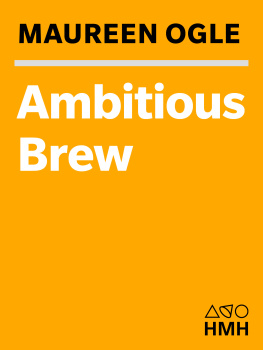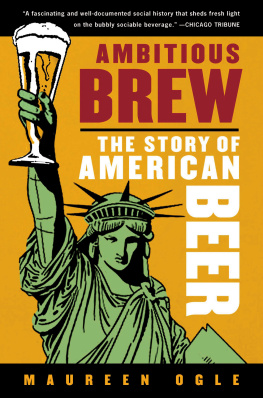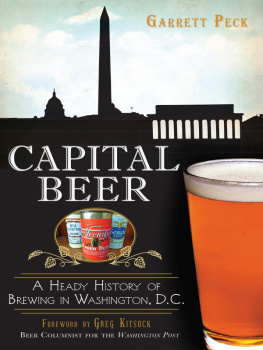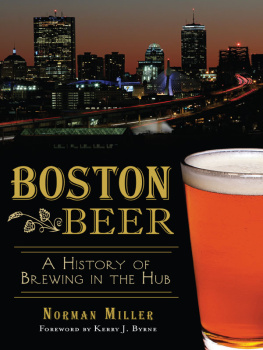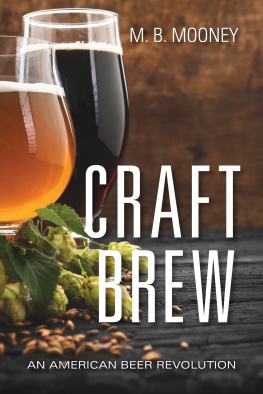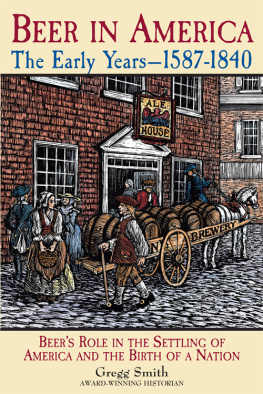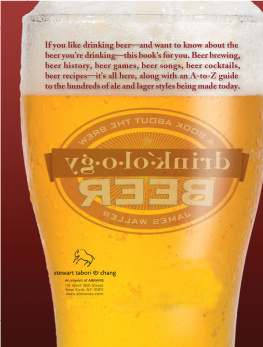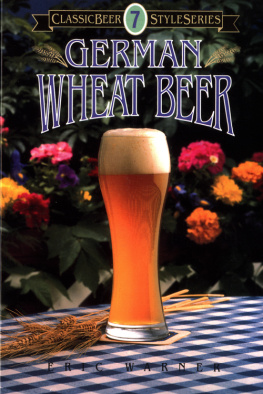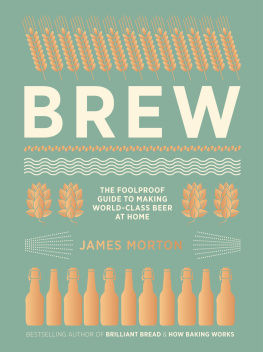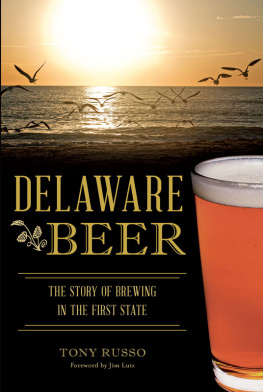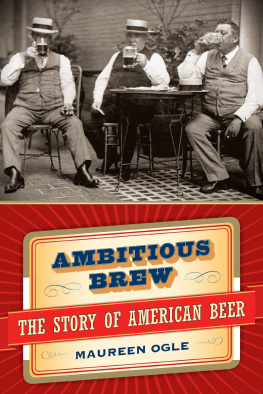Copyright 2006 by Maureen Ogle
All rights reserved. No part of this publication may be reproduced or transmitted in any form or by any means, electronic or mechanical, including photocopy, recording, or any information storage and retrieval system, without permission in writing from the publisher.
For information about permission to reproduce selections from this book, write to or to Permissions, Houghton Mifflin Harcourt Publishing Company, 3 Park Avenue, 19th Floor, New York, New York 10016.
www.hmhco.com
The Library of Congress has cataloged the print edition as follows:
Ogle, Maureen.
Ambitious brew: the story of American beer/Maureen Ogle.
p. cm.
Includes bibliographical references and index.
1. BeerHistory. 2. BrewingHistory.
3. Brewing industryUnited States. I. Title.
TP577.O46 2006
663'.420973dc22 2006011377
ISBN -13: 978-0-15-101012-7
ISBN -10: 0-15-101012-9
e ISBN 978-0-547-53691-0
v3.0116
Introduction
I N THE EARLY SPRING of 2001, I had recently finished writing a book and was trying to think of a topic for my next one. I knew that there was no point in pressing the issue: Writers dont find ideas; the ideas present themselves, and do so in unexpected ways.
One morning, I headed out on a shopping expedition to a small Italian grocery for sausage and pancetta. This store, named after the family that has owned it for over a century, sits in the heart of the citys oldest neighborhood, a relic of the long-gone days when dwellings and families shared their streets with pharmacies and hardware and grocery stores. Painted across the building in huge letters that can be seen several blocks away is the stores name, Graziano Bros., and its founding date, 1912.
I was eyeing the sign and wondering what the shop looked like a century ago when a truck rolled across the street and into my line of vision. It was a very shiny, very red truck, and it was emblazoned with a single word: B UDWEISER .
Wham! That was it. I would write a history of beer in America.
I spent the next several weeks reading what few books there were on the subject and telling everyone I saw about my great new idea. I was fascinated and surprised by their responses. Invariably, they said one of two things: Did I want some help with the research (a joke usually accompanied by a wink and a nudge)? Or they talkedranted is more like itabout what an embarrassment American beer was, thanks to the giant corporate breweries that had ruined it.
I laughed at the jokes, but the humor revealed genuine unease and discomfort. We Americans have an ambivalent relationship with alcohol. On one hand, we drink because we enjoy the way beer and wine taste with food, or for relaxation and sociability. On the other hand, we fear that even a single drink will damage our ability to work and produce. Think what happens when someone orders a beer at lunchtime: The bottle or glass arrives, and so does a raised eyebrow of disapproval or a ribbing about not getting much work done the rest of the day.
The complaints about corporate brewers were more troubling. At the time, I knew nothing about beerhistorical or otherwiseshort of what I learned downing plastic cups of the stuff during dime beer hour at the Vine in Iowa City back in college. To my surprise, however, my ignorance placed me in a minority. It seemed as if everyone I ran into already knew the history of beer in America, and they were more than happy to fill me in on the facts, which went something like this:
Back in the old days, Americans enjoyed an abundance of fine, local beers from thousands of breweries that were artisan workshops where skilled brewers crafted ales using only four ingredients: malt, hops, yeast, and water.
Prohibition ended that halcyon age. When beer came back in the 1930s, hundreds of breweries opened their doors. Most were owned by old brewing families who were determined to brew only the finest and purest of beers. Alas, their dreams died aborning, thanks to the conniving of a handful of corporate behemothsmost notably Anheuser-Busch, Schlitz, Pabst, and Miller.
These Big Brewers scorned honest beer in favor of watery swill brewed from cheap corn and rice. The Big Brewers added insult to injury by using crass commercials, linked mostly to professional sporting events, to sell their foul brew to working-class people. By the 1970s, only a handful of brewers remained and American beer was a thin, yellow concoction with no flavor and even less body.
Baby boomers to the rescue. In the 1960s and 1970s, young Americans backpacked through Europe and there discovered real ales and stouts. They returned eager to try their hand at making those beers at home. In the 1980s, some of the homebrewers opened microbreweries and brewpubs. These new artisans crafted beer of the purest and most flavorful sortand so real beer was rescued from the evil corporate dragons.
I started to wonder: Did the world really need a rehash of this apparently well-known story? Was there anything new to tell about beer in America?
My fears were for nought. As I dug through archives and old trade journals, I discovered that almost every aspect of that oft-told tale of skullduggery, greed, and woe was false and that the truth was considerably more interesting and complex.
Beers history, I learned, embodies the essence of what it is to be American: our ambivalent attitude toward alcohol, our passion for invention and creativity, and our seemingly limitless ability to take old ideas and things and remake them in our uniquely American image. But beers history is also a tale of gamblers and entrepreneurial visionaries, as well as the cultural clashes that are inevitable in a democracy where ideas and values are freely debated.
It is the tale of Frederick Pabst, a sea captain who entered the beer business when he married a brewers daughter and, forty years later, helmed the worlds largest brewery. Of Ken Grossman, a California bicycle repairman and home brewer who built a brewery with his own hands and transformed that small start into the nations ninth largest beer-making establishment. Of Howard Hyde Russell and Wayne Wheeler, who founded the organization that produced Prohibition and shut down thousands of breweries. Of Carl Conrad, who imagined an American version of a Bohemian beer, one that he called Budweiser, and Otto Lademan, the St. Louis brewer who tried to steal it from him. Of Charlie Papazian, a home-brewing enthusiast with no business background, whose zeal for beer inspired him to found not one but two national brewing groups. Of the Busch, Yuengling, and Leinenkugel families, who have kept their breweries alive from one generation to the next for decades on end, and in one of the most competitive and volatile of industries.
What I found was a truly American tale of ambition and passion populated by a cast of remarkable human beings. Here is their story.
CHAPTER ONE
German Beer, American Dreams
L ATE SUMMER , 1844. Milwaukee, Wisconsin Territory. Phillip Best elbowed his way along plank walkways jammed with barrels, boxes, pushcarts, and people. He was headed for the canal, or the Water Power, as locals called it, a mile-long millrace powered by a tree-trunk-and-gravel dam on the Milwaukee River. Plank docks punctuated its tumbling flow and small manufactoriesa few mills, a handful of smithies and wheelwrights, a tannery or twolined its length. Best was searching for a particular business as he pushed his way past more carts and crates, and dodged horses pulling wagons along the dirt street and laborers shouldering newly hewn planks and bags of freshly milled grain. He had been in the United States only a few weeks, and Milwaukees bustle marked a sharp contrast to the drowsy German village where he and his three brothers had worked for their father, Jacob, Sr., a brewer and vintner.
Next page
